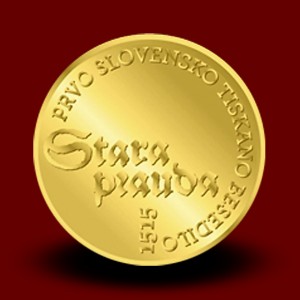0
0
No products
Shipping
0,00 €
Tax
0,00 €
Total
Prices are tax included
Product successfully added to your shopping cart
Quantity
Total
There are 0 items in your cart. There is 1 item in your cart.
Total products
(tax incl.)
Total shipping (tax incl.)
Tax
0,00 €
Total
(tax incl.)
Categories
| Mass | 7 g | ||
| Purity | 900 / 1000 | ||
| Gold content | 6,3 g |
||
| Dimensions (diameter) | 24 mm |
||
| Face value | 100 EUR | ||
| Strike year | 2015 | ||
| Mintage | 1500 |
In the middle of the 15th century, handwritten literature began to be replaced by the first printed texts called incunabula. There were no printing presses in the Slovenian lands at that time, but Jernej Pelušič and Jernej Budrio, two natives of Koper, worked at printing workshops in Venice, while the prominent printer Matevž Cerdonis of Slovenj Gradec worked in Padua.
The 16th century saw the printing of the first leaflets, the forerunners of newspapers, and they served to inform the public about political events, rulers and unusual things in the world of nature or human life.
The pan-Slovenian peasant uprising began in 1515. In Vienna a leaflet was printed with a poem in German describing the rebellious peasants in Carniola and the victory over them. It also bore a Slovenian slogan and the warcry of the Slovenian rebels: “Stara prauda” (old levies) and “Leukhup, leukhup, leukhup, leukhup woga gmaina” (peasants unite), which was probably part of the rebel song. These were the first words printed in Slovenian. A copy of the leaflet is kept at the National and University Library in Ljubljana.
Source: National Museum of Slovenia
On the 500th anniversary of the first Slovenian printed text, the Republic of Slovenia is issuing collector’s coins depicting a facsimile of the Slovenian text on the leaflet printed in 1515.
Coin Designer: Edi Berk, Ljubljana / Slovenia
Minting: Mincovna Kremnica, š.p., Kremnica / Slovakia
| Purity | 900/1000 |
| Delivery | * |
| Tax | Based on Art. 118 and Art. 119 of Value Added Tax Act (ZDDV-1) bullion gold is exempted from VAT in Slovenia. |
| Mint | Mincovna Kremnica |
* required fields



